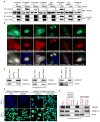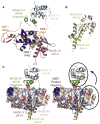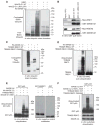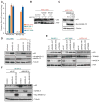MAGE-RING protein complexes comprise a family of E3 ubiquitin ligases
- PMID: 20864041
- PMCID: PMC4509788
- DOI: 10.1016/j.molcel.2010.08.029
MAGE-RING protein complexes comprise a family of E3 ubiquitin ligases
Abstract
The melanoma antigen (MAGE) family consists of more than 60 genes, many of which are cancer-testis antigens that are highly expressed in cancer and play a critical role in tumorigenesis. However, the biochemical and cellular functions of this enigmatic family of proteins have remained elusive. Here, we identify really interesting new gene (RING) domain proteins as binding partners for MAGE family proteins. Multiple MAGE family proteins bind E3 RING ubiquitin ligases with specificity. The crystal structure of one of these MAGE-RING complexes, MAGE-G1-NSE1, reveals structural insights into MAGE family proteins and their interaction with E3 RING ubiquitin ligases. Biochemical and cellular assays demonstrate that MAGE proteins enhance the ubiquitin ligase activity of RING domain proteins. For example, MAGE-C2-TRIM28 is shown to target p53 for degradation in a proteasome-dependent manner, consistent with its tumorigenic functions. These findings define a biochemical and cellular function for the MAGE protein family.
Copyright © 2010 Elsevier Inc. All rights reserved.
Figures






Comment in
-
aMAGEing new players enter the RING to promote ubiquitylation.Mol Cell. 2010 Sep 24;39(6):835-7. doi: 10.1016/j.molcel.2010.09.006. Mol Cell. 2010. PMID: 20864031
Similar articles
-
The melanoma-associated antigen 1 (MAGEA1) protein stimulates the E3 ubiquitin-ligase activity of TRIM31 within a TRIM31-MAGEA1-NSE4 complex.Cell Cycle. 2015;14(6):920-30. doi: 10.1080/15384101.2014.1000112. Cell Cycle. 2015. PMID: 25590999 Free PMC article.
-
MAGE proteins regulate KRAB zinc finger transcription factors and KAP1 E3 ligase activity.Arch Biochem Biophys. 2014 Dec 1;563:136-44. doi: 10.1016/j.abb.2014.07.026. Epub 2014 Aug 7. Arch Biochem Biophys. 2014. PMID: 25107531 Free PMC article.
-
When MAGE meets RING: insights into biological functions of MAGE proteins.Protein Cell. 2011 Jan;2(1):7-12. doi: 10.1007/s13238-011-1002-9. Epub 2011 Feb 20. Protein Cell. 2011. PMID: 21337005 Free PMC article. Review.
-
A Comprehensive Guide to the MAGE Family of Ubiquitin Ligases.J Mol Biol. 2017 Apr 21;429(8):1114-1142. doi: 10.1016/j.jmb.2017.03.005. Epub 2017 Mar 11. J Mol Biol. 2017. PMID: 28300603 Free PMC article. Review.
-
Identification of TRIM22 as a RING finger E3 ubiquitin ligase.Biochem Biophys Res Commun. 2008 Sep 26;374(3):502-6. doi: 10.1016/j.bbrc.2008.07.070. Epub 2008 Jul 24. Biochem Biophys Res Commun. 2008. PMID: 18656448
Cited by
-
Targeting cancer testis antigens in synovial sarcoma.J Immunother Cancer. 2021 Jun;9(6):e002072. doi: 10.1136/jitc-2020-002072. J Immunother Cancer. 2021. PMID: 34083416 Free PMC article. Review.
-
AMPK signaling and its targeting in cancer progression and treatment.Semin Cancer Biol. 2022 Oct;85:52-68. doi: 10.1016/j.semcancer.2021.04.006. Epub 2021 Apr 18. Semin Cancer Biol. 2022. PMID: 33862221 Free PMC article. Review.
-
TRIM28 regulates the nuclear accumulation and toxicity of both alpha-synuclein and tau.Elife. 2016 Oct 25;5:e19809. doi: 10.7554/eLife.19809. Elife. 2016. PMID: 27779468 Free PMC article.
-
Integrative analysis reveals unique structural and functional features of the Smc5/6 complex.Proc Natl Acad Sci U S A. 2021 May 11;118(19):e2026844118. doi: 10.1073/pnas.2026844118. Proc Natl Acad Sci U S A. 2021. PMID: 33941673 Free PMC article.
-
HEPA and PARSE: Systematic discovery of clinically relevant tumor-specific antigens.Oncoimmunology. 2013 Mar 1;2(3):e23249. doi: 10.4161/onci.23249. Oncoimmunology. 2013. PMID: 23802073 Free PMC article.
References
-
- Barker PA, Salehi A. The MAGE proteins: emerging roles in cell cycle progression, apoptosis, and neurogenetic disease. J Neurosci Res. 2002;67:705–712. - PubMed
-
- Bolli M, Kocher T, Adamina M, Guller U, Dalquen P, Haas P, Mirlacher M, Gambazzi F, Harder F, Heberer M, et al. Tissue microarray evaluation of Melanoma antigen E (MAGE) tumor-associated antigen expression: potential indications for specific immunotherapy and prognostic relevance in squamous cell lung carcinoma. Ann Surg. 2002;236:785–793. discussion 793. - PMC - PubMed
-
- Borden KL. RING domains: master builders of molecular scaffolds? J Mol Biol. 2000;295:1103–1112. - PubMed
-
- Brasseur F, Rimoldi D, Liénard D, Lethé B, Carrel S, Arienti F, Suter L, Vanwijck R, Bourlond A, Humblet Y, et al. Expression of MAGE genes in primary and metastatic cutaneous melanoma. Int J Cancer. 1995;63:375–380. - PubMed
Publication types
MeSH terms
Substances
Associated data
- Actions
Grants and funding
LinkOut - more resources
Full Text Sources
Other Literature Sources
Molecular Biology Databases
Research Materials
Miscellaneous

